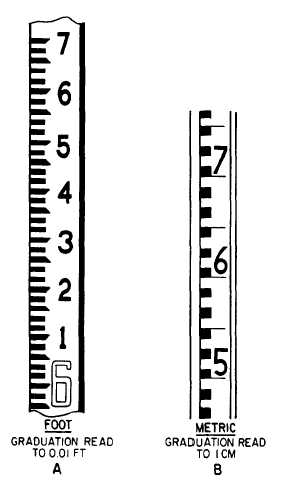of sight and a required point above or below it.
This point may be a permanent elevation (bench
mark), or it may be some natural or constructed
surface.
There are several types of leveling rods. The
most popular of all is the Philadelphia rod, as
shown in figure 11-48. it is a graduated wooden
rod made of two sections and can be extended
from 7 to 13 ft. In view A, each foot is subdivided
into hundredths of a foot. Instead of each
hundredth being marked with a line or tick, the
distance between alternate ones is painted black
on a white background. Thus, the value for each
hundredth is the distance between the colors; the
TOP of the black, EVEN values, the BOTTOM
of the black, ODD values. The tenths are
numbered in black, the feet in red. This rod may
be used with the level, transit, theodolite, and with
the hand level on occasion to measure the
difference in elevation.
Figure 11-48.-Philadelphia rod.
The leveling rod may be read directly by the
instrumentman sighting through the telescope, or
it may be target-read. Conditions that hinder
direct reading, such as poor visibility, long sights,
and partially obstructed sights, as through brush
or leaves, sometimes make it necessary to use
targets. The target is also used to mark a rod
reading when numerous points are set to the same
elevation from one instrument setup.
Targets for the Philadelphia rod are usually
oval, with the long axis at right angles to the rod,
and the quadrants of the target painted alternately
red and white. The target is held in place on the
rod by a C-clamp and a thumbscrew. A lever on
the face of the target is used for fine adjustment
of the target to the line of sight of the level. The
targets have rectangular openings approximately
the width of the rod and 0.15 ft high through
which the face of the rod may be seen. A linear
vernier scale is mounted on the edge of the
opening with the zero on the horizontal line of
the target for reading to thousandths of a foot.
When the target is used, the rodman takes the rod
reading.
The other types of leveling rods differ from
the Philadelphia rod only in details. The Frisco
rod, for direct reading only, is available with two
or three sliding sections. The Chicago rod is
available with three or four sections that, instead
of sliding, are joined at the end to each other like
a fishing rod. The architect’s or builder’s rod is
a two-section rod similar to the Philadelphia but
is graduated in feet and inches to the nearest
one-eighth in. rather than decimally. The upper
section of the Lenker self-computing rod has the
graduations on a continuous metal belt that can
be rotated to set any desired graduation at the level
of the height of the instrument (HI). To use the
rod, you set the rod on the bench mark and bring
the graduation that indicates the elevation of the
bench mark level with the HI. As long as the level
remains at that same setup, wherever you set the
rod on a point, you read the elevation of the point
directly. In short, the Lenker rod does away with
the necessity for computing the elevations.
View B (fig. 11-48) shows the rod marked with
metric measurements; the graduations of the rod
are in meters, decimeters, and centimeters. The
targets that are furnished with the metric rod have
a vernier that permits reading the scale to the
nearest millimeter. The metric rod can be extended
from 2.0 to 3.7 meters.
For high-precision leveling, there are precise
leveling rods as well as precise engineer’s levels.
A Lovar rod is usually T-shaped in cross section
11-43

